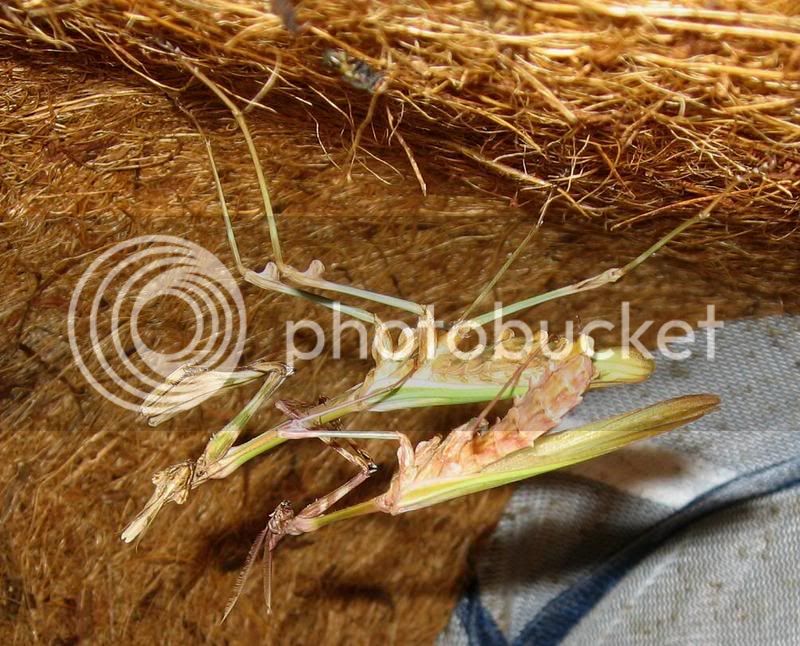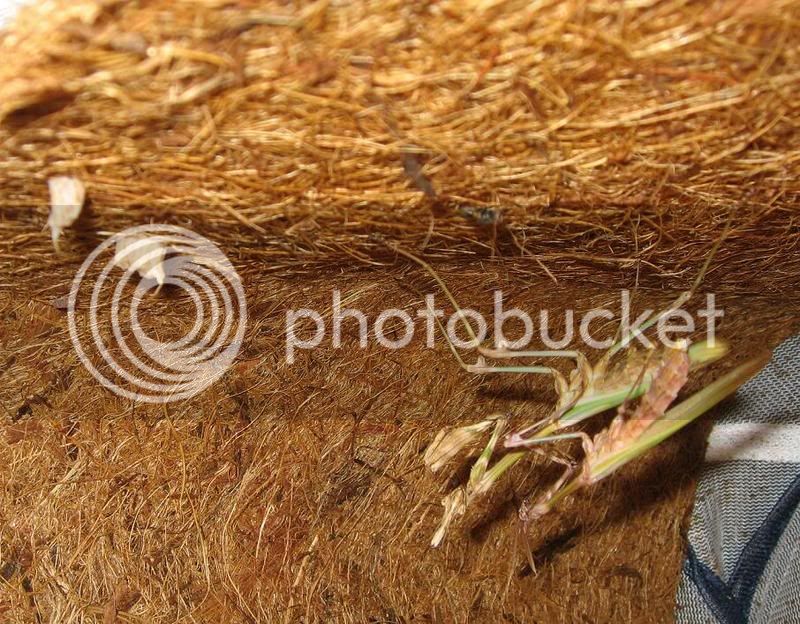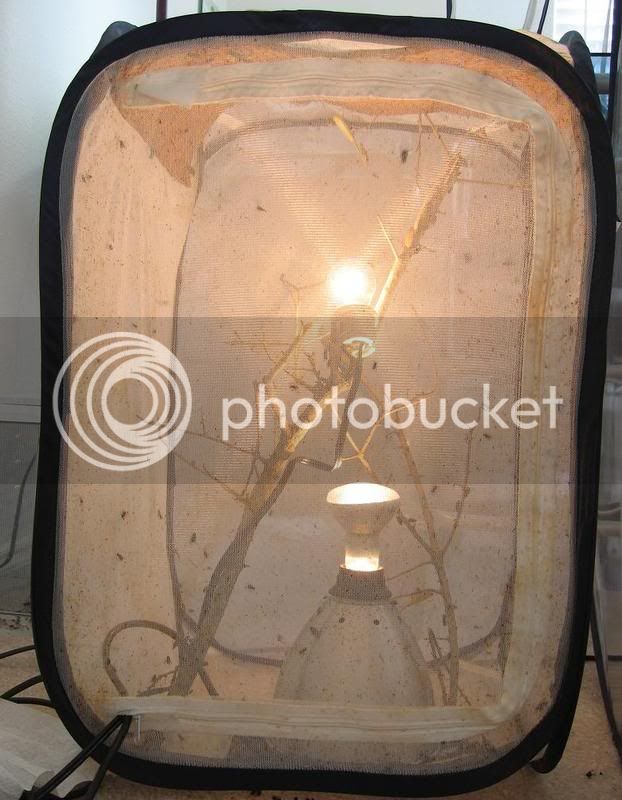Empusa are really quick developers. If she laid an ooth after a week, she must have mated. Unmated females lay their first ooth much later. Of course a pairing doesn't warrant a fertilization, so let him mate with her several times. But be careful: Adult females may suddenly turn to male killers.
You are using an out of date browser. It may not display this or other websites correctly.
You should upgrade or use an alternative browser.
You should upgrade or use an alternative browser.
Empusa mantis
- Thread starter yen_saw
- Start date

Help Support Mantidforum:
This site may earn a commission from merchant affiliate
links, including eBay, Amazon, and others.
I had a situation with my Idolomorpha lateralis, when a sub-adult femala attacked an adult female, because she wanted to snatch a house fly, that was hanging from the aduld female's leg - fortunately nothing wrong had happened - they seem to get along pretty well.
Yes, i was just surprise to see an adult female mantis can produce ootheca that soon. If it wasn't for the cage is newly set-up i would have thought it was an old ooth accidentaly left out previously. :lol:Yeah, mating always accelerates the process of depositing ooths - in my case, most females of various species held on for a couple of weeks, even if power-fed and kept at high temperatures. Then, after mating - sometimes even a few hours after - they were laying their first ooths. For example - I let my O. Distinctus eat zounds of crickets and wax moths for ten days or so, and then I introduced the male to her - it was around midnight. The next morning I checked on them, and the female had deposited her first ooth - and it was fertile.
My other Empusidae have been adult for about two weeks - no ooths so far, even though they have a nearly constant supply of food - so I'd wager the possibility, that your ooth may be fertile.
and guess what, today i went to check the cage again after the reunion dinner. Lo and behold! I found another ooth!!! looks like she can't wait to unload her "stuff" :lol: this time i finally caught them mating.

in the pic below you can see two oothecae on the left

I guess she must have been mated as well, they are two very matured male in the same cage. GUess it is probably good to remove one of the male just in case. Now i wish my second female can mature soon.Empusa are really quick developers. If she laid an ooth after a week, she must have mated. Unmated females lay their first ooth much later. Of course a pairing doesn't warrant a fertilization, so let him mate with her several times. But be careful: Adult females may suddenly turn to male killers.

$34.99
$39.99
RESTCLOUD 30" Large Monarch Butterfly Habitat Cage, Outdoor Insect Mesh Cage Terrarium 16.5" x 16.5" x 30"
Restcloud

$39.95 ($39.95 / Ounce)
Creation Cultivated 32oz Fruit Fly Culture - Live Feeder Insects for Praying Mantis, Jumping Spiders, Geckos, Lizards, Dart Frogs (Wingless Drosophila Melanogaster)
Creation Cultivated

$39.95 ($1.25 / Ounce)
Creation Cultivated 32oz Fruit Fly Culture - Live Feeder Insects for Praying Mantis, Jumping Spiders, Geckos, Lizards, Dart Frogs (Drosophila Hydei Flightless)
Creation Cultivated

$12.99 ($0.03 / Count)
Predator Foods Bulk Live Mealworms - 500 Count (Medium - 0.5")
Predator Foods

$2.99
Praying Mantises pets. Praying Mantis Guide for Owners. Praying Mantis care.
Amazon.com Services LLC

$14.99 ($0.47 / Ounce)
Fresh Fruit Fly Culture (Drosophila Hydei) - Praying Mantis Mantid Frog Lizard Food - 32oz Cup
Surmen Legacy
Those net cages are nice, I also use similar ones frequently. However, they are not suited for every Empusid at any time. During winter, they are not as useful for tropical species, as they are badly isolated and you need (a) strong lamp(s) and hence more energy to achieve the required temperature. They are very best for overwintering Empusa on the balcony or in a cold corridor and for being placed in full sun or half-shadow in summertime. Yen, of course, has fewer climate problems in Texas. :lol: But we Gulf-Stream dependents over here are not as lucky... 
macro junkie
Dead Leaf Mantis
i just bought 3 big ones and 3 small ones,. mantis place i got them ships to uk..u can do the same..Geez, I wish we had net cages like this one available in Poland, it would make things much easier fom many of those, who are mostly into Empusidae.
What was the cost of the cages and the shipment?
By the way - this morning I found out, that my first I. lateralis male moulted for the last time, and I should be ready to introduce him to my females on the Valentine's Day - yeah!
By the way - this morning I found out, that my first I. lateralis male moulted for the last time, and I should be ready to introduce him to my females on the Valentine's Day - yeah!
Yes i guess Texas is blessed with the moderate climate, but that cage is not compeltely covered by the coconut fiber, only the top part. I have to include 2 light bulbs to provide the required 95-100F as well. The honey water dries up pretty quick under that kind of temp. so i need to refill it often. The painful part is those annoying house flies escape whenever i remove the cup for refilling. Well, that's why people say "no pain no gain"!! Here is the set-up for my empusa, if you remember it is pretty much the same set-up i used for my idolomantis nymphs.Those net cages are nice, I also use similar ones frequently. However, they are not suited for every Empusid at any time. During winter, they are not as useful for tropical species, as they are badly isolated and you need (a) strong lamp(s) and hence more energy to achieve the required temperature. They are very best for overwintering Empusa on the balcony or in a cold corridor and for being placed in full sun or half-shadow in summertime. Yen, of course, has fewer climate problems in Texas. :lol: But we Gulf-Stream dependents over here are not as lucky...

Last edited by a moderator:
They don't get burned by the lamps?
Hmmmm - maybe you could just simply use a syringe to refill the cups with water?
With the net cage, you can always just leave a handkerchief dipped in honey water and leave it on the top of the enclosure.
Hmmmm - maybe you could just simply use a syringe to refill the cups with water?
With the net cage, you can always just leave a handkerchief dipped in honey water and leave it on the top of the enclosure.
:blink: Shouldn't the light come from above? I find this system rather strange. :huh:
Regarding the fly food: use pure honey. It doesn't dry but cristallizes to sugar when it looses moisture. This doesn't matter, as fly saliva dissolves sugar. Use some kind of mesh or some other device if you use large amounts of honey to prevent the flies from drowning. The drinking water can be provided by spraying.
Regarding the fly food: use pure honey. It doesn't dry but cristallizes to sugar when it looses moisture. This doesn't matter, as fly saliva dissolves sugar. Use some kind of mesh or some other device if you use large amounts of honey to prevent the flies from drowning. The drinking water can be provided by spraying.
That doesn't matter. Animals (except those using warm stones) associate radiation heat with light and light with the sun. That's why light should come from above or at least one upper corner. However, if it works like this it's ok. It's just unusual.
Thanks for the input guys!! yeah it is kind of odd to have the light coming from bottom, i will think of a way to hang the light bulb from top. Current method allows a cooler spot at the bottom of the cage. I used just honey before, but many flies get stucked and die there so i changed it to honey water with tower paper in the cup so the flies won't drown. The bulb is only of 40 and 45W, not hot enough to burn the stick but i do set it in such a way that it won't be in direct contact with the net or dry leaves/stick. The top portion of the net cage is all covered up by the coconut fiber so can't pour any honey water from top unfortunately 
Sometimes I put the light source on the side of the enclosure, and this makes mantids congregate there - but since it's Texas Unicorn, it don't really matter - they can climb soft surfaces, and they feel comfortable there. Though I plan on using lamps which do not give any light at all - just the UV radiation and heat - I do not want to attact mantids where they shoult not be. I still do not know what species I want to keep there - Gongylus or Idolomantis - I hanker after both, but I don't want to be pre-occupied with too many.
Man, those Empusidae have some really tricky requirements.
As for feeding flies - I always do it from the top-side. I just hate when they get ensnared or poo all over the honey.
Yen - you can stick the paper towel to the side of the net cage, flys will find their way to the honey - prepare water with honey dissolved in it, and spray the towel from time to time - should be okay.
Man, those Empusidae have some really tricky requirements.
As for feeding flies - I always do it from the top-side. I just hate when they get ensnared or poo all over the honey.
Yen - you can stick the paper towel to the side of the net cage, flys will find their way to the honey - prepare water with honey dissolved in it, and spray the towel from time to time - should be okay.
Last edited by a moderator:
Yeah, hope i didn't confuse the empusa enough to think the world is upside down :lol: By the way, i was told the ooth of Empusa sp do hatch fairly quick if fertile, in 3 weeks? is that possible? I hope the "upside-down" light/heat source won't mess up anything.That doesn't matter. Animals (except those using warm stones) associate radiation heat with light and light with the sun. That's why light should come from above or at least one upper corner. However, if it works like this it's ok. It's just unusual.
Yes i have seen bunch of the Texas unicorn nymphs clump up to the spot closet to the light/heat source. I have seen it on the idolomantis too, that basically means MORE heat is neededSometimes I put the light source on the side of the enclosure, and this makes mantids congregate there - but since it's Texas Unicorn, it don't really matter - they can climb soft surfaces, and they feel comfortable there. Though I plan on using lamps which do not give any light at all - just the UV radiation and heat - I do not want to attact mantids where they shoult not be. I still do not know what species I want to keep there - Gongylus or Idolomantis - I hanker after both, but I don't want to be pre-occupied with too many.Man, those Empusidae have some really tricky requirements.
As for feeding flies - I always do it from the top-side. I just hate when they get ensnared or poo all over the honey.
Yen - you can stick the paper towel to the side of the net cage, flys will find their way to the honey - prepare water with honey dissolved in it, and spray the towel from time to time - should be okay.
ok, let me see how the paper towel method will work, but is will sure dry up pretty fast i reckon.
Well, the heat goes from the bottom, to the top - but the side should not be that warm, so it should not dry as fast as it would on the top of the enclosure. You can leave a small opening by not zipping the zipper, and stuffing the paper towel there or something like that.Yeah, hope i didn't confuse the empusa enough to think the world is upside down :lol: By the way, i was told the ooth of Empusa sp do hatch fairly quick if fertile, in 3 weeks? is that possible? I hope the "upside-down" light/heat source won't mess up anything.Yes i have seen bunch of the Texas unicorn nymphs clump up to the spot closet to the light/heat source. I have seen it on the idolomantis too, that basically means MORE heat is needed
ok, let me see how the paper towel method will work, but is will sure dry up pretty fast i reckon.
I have been thinking about using those small water tanks they use for hamsters and other small animals - but I don't know if it will work out.
Yes, Empusa ooths hatch in just 2-4 weeks, as they have their diapause in the larval stage.i was told the ooth of Empusa sp do hatch fairly quick if fertile, in 3 weeks? is that possible?
Of course some flies die if you don't use a mesh or something, but even if there are some drowned ones, there are far less losses to drowning than flying around in your room! And, you have less work, as such a honey cup (I use the cups of plastic bottles), which can be rather small, lasts for quite a while. Last but not least, honey water quickly molds, what is not the case with pure honey.I used just honey before, but many flies get stucked and die there so i changed it to honey water with tower paper in the cup so the flies won't drown.
OGIGA
Dead Leaf Mantis
95-100F is pretty warm... which gives me an idea! Well, I don't have any mantises now, but now I know that I should get some of these mantises when the weather is cold because their tank would warm up my house. 



























